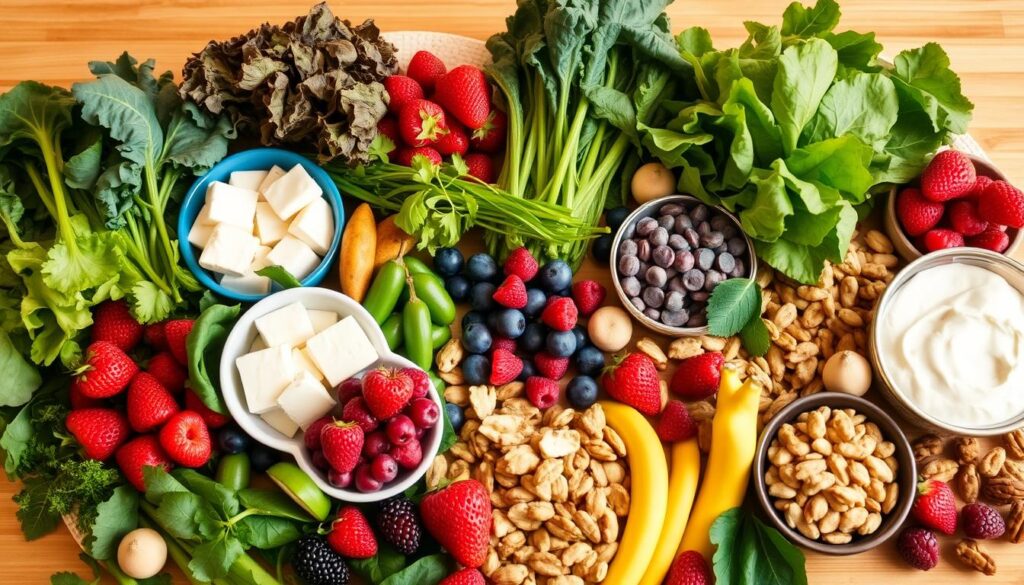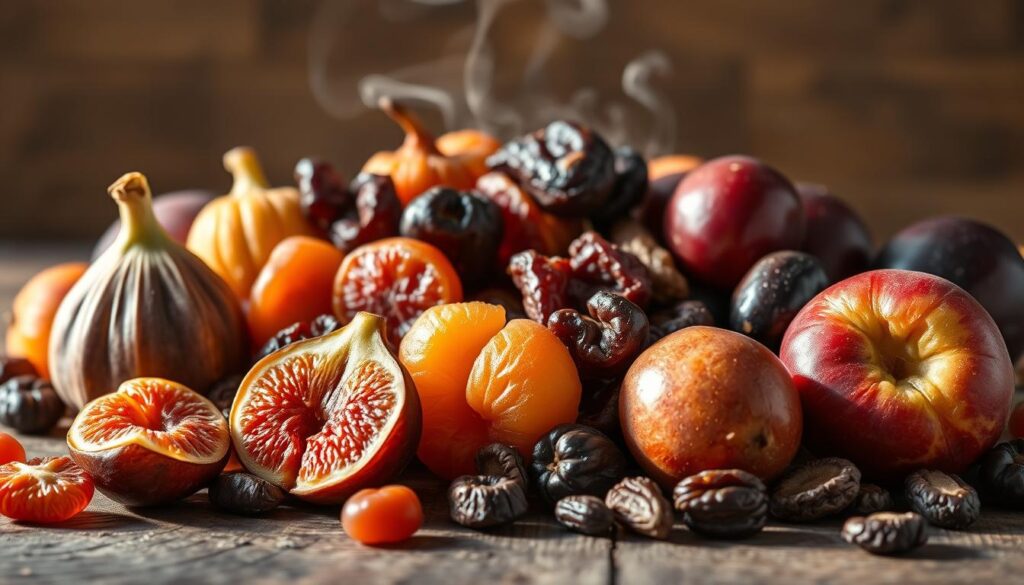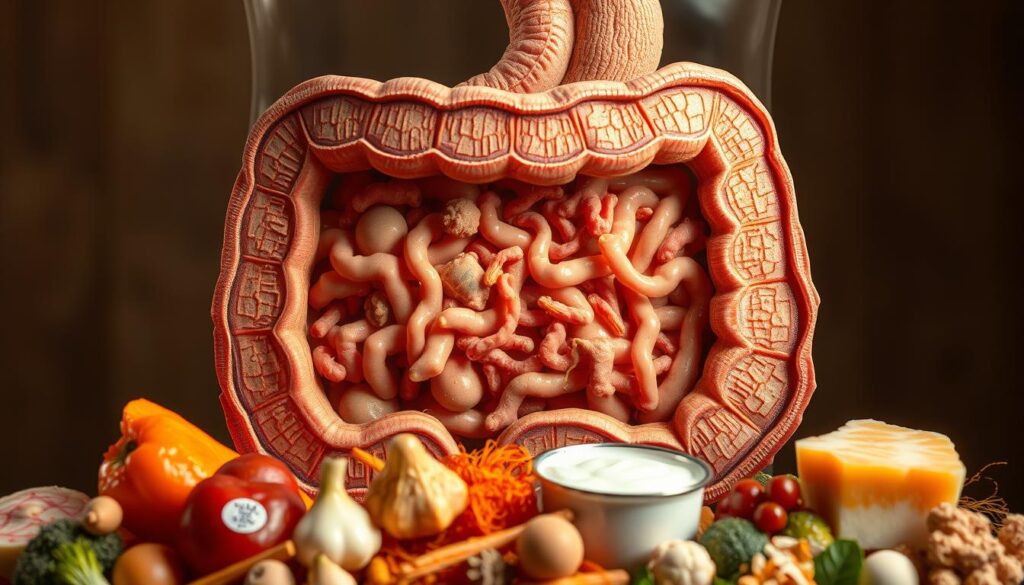The Best Phytoestrogen Foods for Hormonal Balance
You wake up at 3 AM drenched in sweat, your heart racing. Another hot flash disrupts your sleep. If this sounds familiar, you’re not alone. Millions of women struggle with hormonal imbalances that affect their daily lives.
Nature offers a gentle solution through phytoestrogen foods. These foods can help restore your body’s delicate balance. They work like nature’s hormone helpers, mimicking estrogen in your body when you need it most.
Whether you’re navigating menopause nutrition or seeking better hormonal balance, the right foods can help. They can make a real difference in how you feel each day.

From soybeans in your morning smoothie to flaxseeds on your salad, dietary estrogen from plants is safe and natural.
It offers a way to manage symptoms like hot flashes, mood swings, and sleep disruptions. These plant compounds don’t just ease uncomfortable symptoms – they support your overall health.
They protect your bones, heart, and even help reduce certain cancer risks. In this guide, you’ll discover which foods pack the most phytoestrogen power. You’ll learn practical ways to add them to your meals.
You’ll understand how these natural compounds work in your body. They might be the missing piece in your wellness puzzle. Get ready to transform your plate into a powerful tool for hormonal balance.
Understanding Phytoestrogens and Their Role in Your Body
Phytoestrogens are natural compounds found in plants. They have a similar structure to estrogen. When you eat foods rich in phytoestrogens, they interact with estrogen receptors in your body.
This can lead to both estrogenic and antiestrogenic effects, depending on your hormonal needs.
These plant compounds bind to estrogen receptors in your body. Isoflavones, found mainly in soy, and lignans, found in flaxseeds and whole grains, are well-studied.
Your body can use them to either increase estrogen when it’s low or block it when it’s high.
++ Fermented Foods and Menopause: Boosting Gut Health
Eating foods rich in phytoestrogens can have many health benefits. Women going through menopause may experience fewer hot flashes and less vaginal dryness.
Your bones may also get stronger, reducing the risk of osteoporosis. These compounds can also help manage cholesterol levels, keeping your arteries clear and lowering the risk of heart disease.
| Phytoestrogen Type | Primary Food Sources | Key Health Benefits |
|---|---|---|
| Isoflavones | Soybeans, tempeh, tofu | Menopause symptom relief, bone health |
| Lignans | Flaxseeds, sesame seeds, whole grains | Heart health, cancer prevention |
| Coumestans | Alfalfa sprouts, split peas | Antioxidant protection |
Studies show that people eating more phytoestrogens have lower breast cancer rates. Lab research also suggests these compounds can destroy prostate cancer cells. This offers protection for both men and women.
Best Phytoestrogen Foods for Hormonal Balance
Your body needs the right foods to keep hormones in balance. Foods rich in phytoestrogens can help a lot. These plant compounds act like estrogen in your body, helping to keep hormone levels right.
Flax seeds lignans are especially good. Eating just two tablespoons of ground flaxseeds a day can help your body get rid of extra estrogen.
Studies show flaxseeds have more lignans than any other plant, which might lower breast cancer risk in women after menopause.
Soy products are also great, thanks to their soy isoflavones. These compounds help your body feel estrogen-like, making hot flashes less common and less severe.
Tofu and tempeh not only have isoflavones but also protein, prebiotics, and important vitamins.
| Food Source | Key Compound | Daily Serving | Main Benefits |
|---|---|---|---|
| Flax Seeds | Lignans | 2 tablespoons | Estrogen balance, cancer protection |
| Soybeans | Isoflavones | 1/2 cup | Hot flash relief, heart health |
| Sesame Seeds | Phytoestrogens | 1 tablespoon | Bone health, antioxidant protection |
| Tofu | Isoflavones | 3-4 oz | Protein source, hormone support |
Sesame seeds are also worth noting for their strong antioxidant activity.
Eating them daily helps keep bones strong in women after menopause and protects your heart, liver, and kidneys. You can add them to salads or blend them into tahini for a tasty treat.
Cruciferous Vegetables for Hormone Detoxification
Your body needs cruciferous vegetables hormones to stay balanced. These plants have special compounds that help your liver get rid of extra hormones.
When you eat, chop, or cook these veggies, they make indole-3-carbinol. This helps your liver work better. It’s key for removing waste and keeping hormones in check.
Broccoli is especially good, with broccoli phytoestrogens that help your endocrine system.
Also read: How to Build a Menopause-Friendly Plate: Macronutrient Guidelines
Eating these veggies every day helps your body get rid of hormones. Brussels sprouts have coumestrol, which acts like estrogen. Other veggies offer their own benefits.
| Vegetable | Key Compound | Health Benefit |
|---|---|---|
| Broccoli | Secoisolariciresinol | Lignan phytoestrogen support |
| Brussels Sprouts | Coumestrol | Estrogenic activity |
| Kale | Glucosinolates | Anti-inflammatory properties |
| Cauliflower | Sulforaphane | Cancer prevention |
| Cabbage | Anthocyanins | Antioxidant protection |
Adding rocket, bok choy, radish, and more to your meals is good. They fight cancer and inflammation.
Studies show eating these veggies can lower disease risks, like heart problems. Eating them daily helps your body detox naturally.
Read more: Omega-3 Sources to Ease Menopausal Inflammation
Incorporating Dried Fruits into Your Daily Diet
Your pantry might already have some best phytoestrogen foods for hormonal balance. Dried fruits are small but pack a big nutritional punch. They are great for your hormone health and easy to add to your diet.

Dates are at the top with lots of phytoestrogens. Prunes are close behind, helping with hormones and digestion thanks to fiber.
Dried apricots are also great, offering a sweet and tangy option. They add important minerals like potassium and iron.
It’s important to eat these foods wisely. Enjoy a small handful of dates or prunes each day. Mix them with nuts or seeds to keep your energy up. Fresh fruits like berries, apples, and pears are also good. They give you fiber and nutrients.
When you eat dried fruits, do it in the morning. Your body can handle sugars better then. Keep them in airtight containers to keep their nutrients. Choose organic and eat in moderation for long-term health.
Stone Fruits and Berries: Sweet Solutions for Balance
Nature gives us tasty ways to help our hormonal health with colorful fruits. Stone fruits and berries are key in keeping hormones balanced. They’re not just yummy; they also have compounds that help our bodies.
Peaches are full of peaches lignans, which are good for you. Eating two servings of peaches or nectarines a week can lower breast cancer risk in women.
A 2009 study found that lignans in diet may cut breast cancer risk by 15% in postmenopausal women. These fruits are packed with vitamins, minerals, and health-protecting compounds.
Berries phytoestrogens are another great choice for hormone support. Blueberries, raspberries, and cranberries have phytoestrogens, antioxidants, fiber, and important nutrients.
The mix of strawberries blackberries hormones is especially good for your body. Studies show that strawberries and blueberries can protect against breast cancer like stone fruits do.
To get the most benefits, eat these fruits raw with their skin on. This keeps their nutrients and helps control blood sugar.
Enjoy fresh berries in yogurt, snack on sliced peaches, or blend them into smoothies. Your taste buds and hormones will appreciate these natural sweet treats.
Garlic and Red Wine: Surprising Phytoestrogen Sources
You might not expect garlic and red wine to support hormonal balance. Yet, these kitchen staples contain powerful plant compounds. These compounds mimic estrogen in your body. They offer benefits that go beyond their taste.
Garlic adds more than just flavor to your dishes. It has antioxidant and anti-inflammatory properties. These help support bone health, especially after menopause when estrogen levels drop.
Studies show that garlic’s compounds may help keep bones strong. They also offer heart health benefits by lowering cholesterol and blood pressure.
Red wine’s secret is red wine resveratrol, a potent phytoestrogen found in grapes and berries.
This compound helps regulate cholesterol and may stop cancer cell growth in postmenopausal women. A moderate glass of red wine supports heart health with its antioxidants.
Both garlic and red wine affect your body’s hormones in subtle but important ways. Adding fresh garlic or enjoying red wine occasionally supports hormone balance.
These foods show that hormone-supporting nutrients are found in unexpected places in your kitchen.
Building Your Hormone-Balancing Meal Plan
Starting a hormone balancing diet means understanding the role of phytoestrogens and choosing the right foods.
Make sure to include quality protein at every meal to keep your blood sugar stable. Opt for organic, grass-fed meats or plant-based proteins like lentils and chickpeas.
Good fats are essential for hormone production. Add olive oil, flaxseed oil, avocado oil, raw almonds, walnuts, and fresh avocados to your meals. These healthy fats help your body make hormones naturally.
Make sure your plate is full of colorful vegetables. Aim for seven to eight portions a day for a variety of nutrients.
Include a fist-sized portion of whole grains like brown rice, buckwheat, or quinoa. These provide fiber and B vitamins that help balance hormones.
| Meal Component | Examples | Hormone Benefit |
|---|---|---|
| Protein | Wild salmon, organic chicken, tempeh | Stabilizes blood sugar |
| Healthy Fats | Avocado, chia seeds, olive oil | Supports hormone production |
| Vegetables | Spinach, kale, broccoli | Provides phytonutrients |
| Whole Grains | Quinoa, brown rice, oats | Maintains steady energy |
Season your meals with anti-inflammatory herbs and spices. Ginger, turmeric, sumac, paprika, and garlic add flavor and support hormone health.
Include magnesium-rich foods like spinach, watercress, kale, and legumes to improve insulin sensitivity and regulate your nervous system.
Supporting Your Gut Microbiome for Better Hormone Health
Your gut microbiome hormones work together in ways you might not expect. The bacteria in your digestive system are key in producing and regulating hormones. When you feed these good bacteria, your hormones can work better.
Fermented foods phytoestrogens are great for hormonal health. Foods like kefir, sauerkraut, and kimchi have good bacteria.
Tempeh, a fermented soybean product, has probiotics and isoflavones for estrogen balance. Greek yogurt and miso soup also feed your gut bacteria and support hormones.

To balance probiotic hormones, eat a variety of foods. Your gut bacteria love variety. Eat prebiotic foods like garlic, onions, and asparagus to feed them.
Add fermented veggies to your meals every day. Choose whole grains and legumes for gut and hormone health.
The link between your gut and hormones is key during menopause. A healthy microbiome helps get rid of excess hormones and lessens symptoms like hot flashes.
Eating fermented foods regularly and keeping your bacteria diverse helps your body regulate hormones naturally. This is better than relying on single foods or supplements.
Safety Considerations and Potential Concerns
Recent research on phytoestrogen safety in your diet is reassuring. A 2020 study looked at women trying to conceive.
It found no link between phytoestrogen intake and pregnancy rates. This news is good for couples planning families.
Studies from 2020 show phytoestrogens might lower breast cancer risk. They also improve survival rates for breast cancer patients. This means eating these foods can be safe and even beneficial in a balanced diet.
Men concerned about testosterone levels can relax. Studies show phytoestrogens don’t affect male hormones.
A 2021 study and a 2019 review found soy supplements keep thyroid function normal. They only slightly raise TSH levels, which stay within healthy ranges.
| Health Concern | Research Finding | Impact Level |
|---|---|---|
| Fertility | No effect on pregnancy rates | Neutral |
| Breast Cancer | Decreased risk and better survival | Positive |
| Male Hormones | No testosterone changes | Neutral |
| Thyroid Function | Slight TSH increase only | Minimal |
Phytoestrogens can sometimes block natural estrogen. But, eating them in moderation through whole foods is usually safe.
Always talk to your doctor before changing your diet, especially if you have hormone-related health issues.
Conclusion
Phytoestrogen foods are a natural way to improve your health. Foods like flax seeds and soy products are full of nutrients. They help your body in many ways.
Cruciferous vegetables help get rid of bad hormones. Dried fruits and berries add sweetness. Even garlic and red wine have phytoestrogens.
Having a variety of foods is key. Eating quality proteins, fats, and fermented foods is important. Adding sesame seeds, nuts, and peaches boosts your health.
These foods can help with more than just menopause. They can make your bones stronger and your heart healthier. They might even protect against cancer.
You don’t need to make big changes to eat better. Start with small steps. Add ground flax seeds to your smoothie or snack on edamame.
Try whole grain pasta and eat more colorful veggies. These small changes can make a big difference in your health.
New research keeps showing the benefits of these foods. They are safe and effective for managing symptoms and improving overall health. Adding them to your diet can make a big difference.
